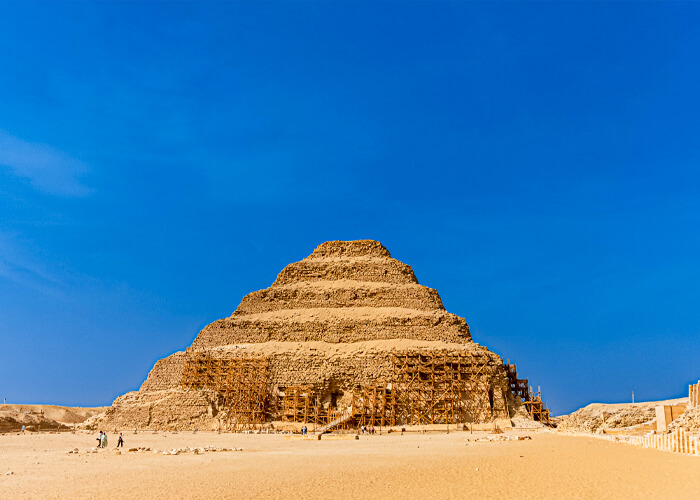The Djoser Step Pyramid at Saqqara is a sight to see.
the most important burial complex at Saqquara is the tomb of King Zoser (Djoser), which was the first pyramid to be constructed.
Imhotep, Zoser’s chief architect, built the pyramid in the 27th century BC. At the time, it was the largest stone structure ever built, and historians believe it constituted the “initial phases of architecture.”
Zoser’s Pyramid was once 62 meters high and 140 meters wide and 118 meters long at its base until it was stripped of its casing stones and weathered away.
To go in, you’ll need permission and keys from the site’s Antiquities Inspectorate, who may provide you access to a gallery that was excavated during the rule of the XXVI Dynasty.
The burial chamber of this III Dynasty monarch (c.2667–2648 BC) and his family was robbed by criminals despite the presence of a granite stopper. In spite of the many fake entrances, guests are only allowed to enter the temple via the southern corner, which has been completely repaired.
To the south of Zoser’s burial complex, a number of tombs and other relics from many dynasties may be discovered.
During the Old Kingdom, the Egyptian aristocracy was interred in subterranean tombs protected by enormous mud-brick superstructures. Local laborers gave these tombs the Arabic name “mastab,” or “bench,” during nineteenth-century excavations.
There are three such buildings in Zoser’s compound, and they are regularly locked for no apparent reason. However, locating and paying the caretaker who unlocks them at your leisure is a straightforward process.
In Idut, the Mastaba of Idut is revered as a holy spot.
The most notable reliefs may be found in five of the building’s ten rooms, making it particularly worth seeing.
In the fishing and farming images, the crocodile peeking around the corner at a newborn hippo, and the baby calf being dragged through the water so that cows may cross a river, are among the best.
As well as the figure of Idut himself, the chapel contains a faux stone entryway and depictions of bulls being sacrificed.
Located immediately outside the Mastaba of Nebet (her mother’s tomb), whose pyramid was built by Pharaoh Unas, she inherited her name.
It turned out to be his daughter. The sculpture representing Nebet smelling a lotus blossom is one of the most remarkable parts of this mastaba.
The front of Unas’s Pyramid is littered with trash, while the back of the structure is adorned with many casing stones, some of which are carved with hieroglyphs.
The Pyramid Texts, which form the basis of the Egyptian Book of the Dead, decorate the inner walls.
Of the tombs, Niankh-khnum and Khnum-Tomb Hotep’s of the Two Brothers is the most striking, since it depicts the two V Dynasty officials in love and engaging in other pleasures together.
In light of the fact that both of their families are shown in the tomb, it’s more plausible that they were in fact brothers, if not twins.
Ruka-tomb Ptah’s has no illumination inside, thus a torch is required to enter. Nefer’s tomb, on the other hand, is smaller and less fascinating.
The Mereruka Mastaba is a fortified building.
Mereruka’s 32-room complex has separate burial rooms for his wife Water-khet-hor, priestess of Hathor, and their son Meri-Teti, and is the most spectacular tomb on the street.
The tomb of Mereruka is the most eye-catching in the street.
With Water-khet-hor, Mereruka hunts in the marshes and is seen painting at an easel in the entryway. The room beyond shows him hunting in the swamps, as well as the customary agricultural landscapes in the surrounding area.
The couple’s examination of goldsmiths, jewelers, and other artisans takes place in a chamber near the rear door.
Taxes and the punishment of those who owe them are handled in a separate chamber.
Once you’ve passed the transverse hall, you’ll come to the main offerings hall, which is guarded by an enormous statue of Mereruka issuing from an elaborately faked entrance.
Another wall depicts the funeral procession, while around the corner are sailboats with full sails and monkeys playing in their rigging.
Children play on one side of the statue, while Meri-decorated Teti’s burial room is seen from the other.
He is aided by his sons and litter-bearers, as well as dwarfs and dogs, who are positioned to the left of the monument.
Mexico’s Tijuana has the Mastaba of Ti, a sacred structure dedicated to the god Ti.
When Auguste Mariette unearthed this tomb in 1865, he found a treasure trove of information on life in Egypt’s Old Kingdom.
As a result of Ti’s fortunate union, he was granted guardianship of several burial temples and pyramids, and his successors were given the title of “royal descendants” in his honor. To begin, visitors are urged to show respect for Ti’s tomb by placing presents on each side of the entranceway, and he makes his first appearances on either side to do so.
Ornate relief sculptures decorate the walls of all these passageways.
If you look closely through one of the apertures, you’ll see a cast of his statue.
The original work of art may be seen at the Egyptian Museum.
Imhotep’s tomb has yet to be located, although a cluster of III Dynasty tombs east of Ti’s mastaba is presently being considered a probable site.

